The history of the founding of the unisex style

Look stylish and fashionable every day is the dream of any woman, regardless of age, status and income. Modern fashion makes this possible. Unisex clothing, comfortable and relatively inexpensive, is suitable for both work and play.




Unisex. What is it?
Translated from English, this term sounds like "one gender", such things can be included in the wardrobe of both men and women. Of course, if we are talking about clothes that fit the body tightly (jeans, shorts, trousers and jackets, shirts), then, due to anatomical differences, their cut will be different. Loose, as well as outerwear (T-shirts, turtlenecks, hats, coats, jackets), versatile and suitable for everyone, regardless of gender.




In addition, the unisex style includes accessories, shoes, perfumes and hairstyles.
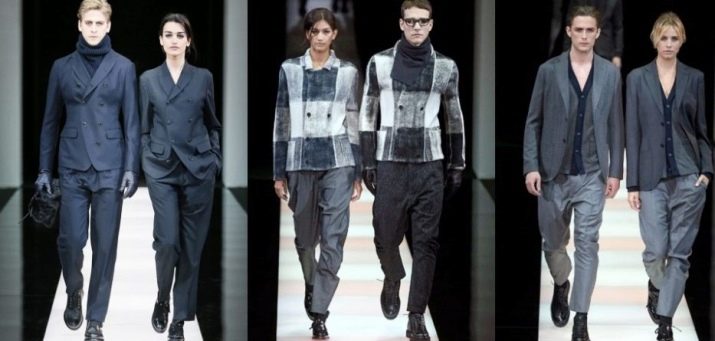
Style history
For the first time, women donned trousers in the 1920s, after the First World War, when they had to replace the men who died at the front. But this was a forced measure: it is difficult to perform physical work in fluffy skirts.



The history of unisex as a fashion trend began later, in the 1960s. in Europe. None of the researchers can name the exact reason for the emergence of the idea of this style. Perhaps she is associated with the feminist movement, or with the youth subcultures of punks and hippies.

The famous Coco Chanel believed that only a fusion of male and female styles could make the perfect suit. She literally revolutionized the way she looked at fashion. The bold Frenchwoman was one of the first to appear in society with a short haircut and trousers. Deciding to free women from tight corsets and uncomfortable skirts, she introduced trousers, soft jackets that did not restrict movement, and men's hats as elements of a woman's image.


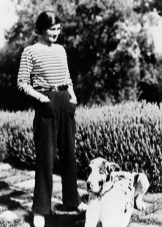

The idea of comfortable and practical trouser suits appealed to women all over the world. The fashion trend began to enter life.And although trousers on a woman were considered a violation of decency for some time, many couturiers developed collections of suits for every day, for business meetings and even for special occasions.

At the same time, the American fashion designer of Austrian origin, Rudi Gernreich, put forward the idea that there should be no difference at all between men's and women's clothing. He plunged the audience into a state of shock by showing a collection of underwear (thongs and transparent bras) and swimwear in the form of jumpsuits.
Unisex swimwear was meant for both men and women. In this case, the bottom of the swimsuit was a thong, exposing the buttocks, and the top was completely absent. The straps started under the bust, leaving her completely naked. Society did not accept such a scandalous design for swimwear.

The heyday of the style comes in the 1990s. and is associated with the name of Calvin Klein. The famous American fashion designer has developed a line of youth clothing for girls and boys, consisting of wide jeans and hoodie sweaters.




The young people were delighted with the new models.
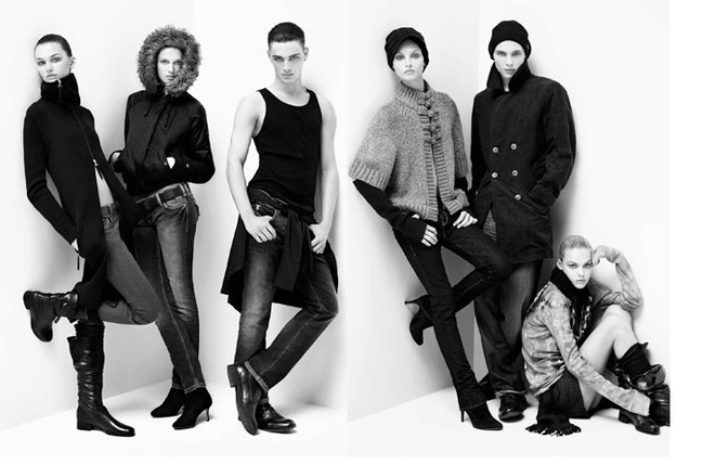
And yet the world famous founder of the unisex style and its ideological inspirer is considered the extraordinary and genius couturier Yves Saint Laurent.

Style Creator
Yves Saint Laurent was born in 1936 in Algeria to the family of a lawyer.


Yves showed a penchant for modeling clothes already in childhood, so it is not surprising that for admission he chose a school under the Syndicate of Haute Couture in Paris, where his family moved in 1954.
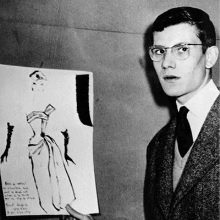


Already in the first year of study at the competition for young designers, he wins first place for a cocktail dress. The sketches of his models go to Christian Dior, who was at the peak of his popularity at that time.


The views of a fashion guru and an aspiring fashion designer on elegance and beauty coincided. And at the age of 19, Yves became an assistant to Dior himself, while working as a tailor's apprentice.



1957 year
After the death of the great Dior, the Dior fashion house was headed by 21-year-old Yves Saint Laurent.


The first fashion show of the young art director turned out to be innovative. Instead of the usual fitted silhouettes, the audience saw A-shaped short dresses, loose, but no less feminine. The collection, named "Trapezium", caused delight by its unexpectedness. However, after such a miraculous take-off, a violent fall followed.



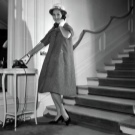

1959 year
Unisex ideas, floating in the atmosphere of fashion, inspired the designer to take a revolutionary step. He put on short leather jackets and suits over turtlenecks for the models.


The society was not ready for such a sharp turn. And the collection of Yves Saint Laurent suffered a fiasco.

This was used by Mark Boan, who was haunted by the success of the "daring upstart". He became the head of the House of Dior, and the former director was fired and drafted into the army.
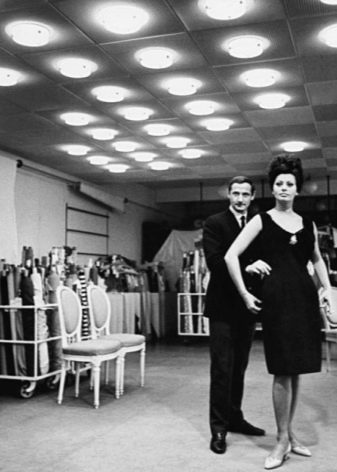

1960 year
Yves does not just get into the service, he is sent to Algeria, where hostilities are being conducted at this time. Flashes of explosions instead of spotlights on the podium, the roar of guns instead of applause from the audience, rude and dirty soldiers instead of graceful models - all this could not but affect the tender psyche of a young man.
Returning from the army after 20 days, with a diagnosis of neurasthenia, he ends up in a psychiatric hospital. Later, Yves Saint Laurent uses alcohol and drugs as relaxins, and until the end of his life he cannot get rid of this addiction.




But Africa affected more than just his health. Even in the war, he remained a creative person, and, of course, drew attention to the bright colors and folk costumes of the indigenous people of the African continent.


1961 year
With the help of his friend and lover Pierre Berger, Yves was able to sue Dior for a significant amount for illegal dismissal. With this money and funds from sponsors from the United States, he founded the Yves Saint Laurent Fashion House.
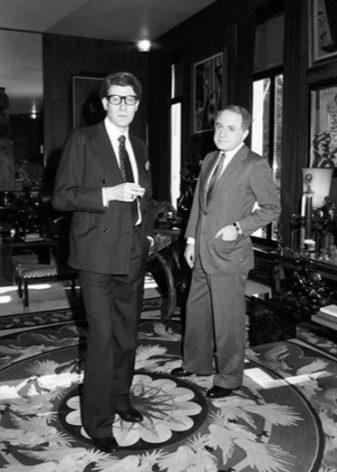

1962-1963 biennium
The shows of the first collections made a splash in society. Black leather jackets and jackets, motorcycle helmets, over the knee boots were controversially accepted by contemporaries.


1965 year
The light saw the new collection "Mondrian", with a color print, transferred from the canvases of the abstract artist Piet Mondrian, in whose honor it was named. The geometric patterns so struck Yves' imagination with their perfect precision that he transferred them to the materials from which loose trapeze dresses were sewn.

Love for the fine arts was expressed in the art of the designer. Following Mondrian's geometry, he likewise used Picasso's harlequin and Braque's pigeons, creating luxurious jackets with Van Gogh's sunflowers.

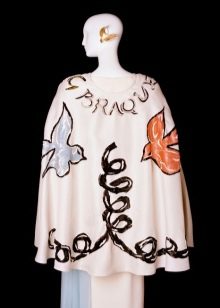

And in 1976 Yves Saint Laurent dedicated his collection to Diaghilev's Russian Seasons.

1966 year
The popularity of the unisex style is gaining momentum. And now the famous fashion designer Yves Saint Laurent presents the world with a tuxedo for women. It should be noted that this costume was an element of the wardrobe exclusively for men.
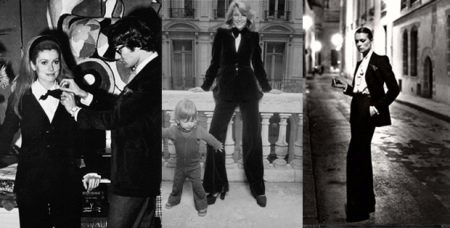
The Le Smoking collection, despite the initial shock, was a success, in part thanks to the publication of the models in the fashion magazine Vogue.
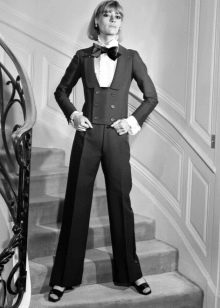


1967 and 1968
Collections were created in African style, using ethnic motives, and in safari style, clothing for travel and leisure.





During this period, in one of the nightclubs, Eve meets an extravagant girl from a socialite, Betty Catru. Like most gay men, Yiwa liked androgynous women. But the attention of the fashion designer was attracted not so much by the type of the girl as by the style of her clothes. Betty preferred "men's" things (trousers, jackets, jeans). Friendship with her pushed Yves Saint Laurent to create unisex clothes.

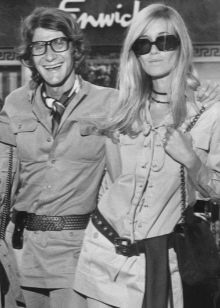

The renowned fashion designer worked not only on haute couture, he also designed casual wear. His desire to make all women beautiful and elegant led to the creation of the pret-a-porter line (literally “ready to wear”). The first Rive Gauche boutique was opened in 1966. Any fashionista could buy designer clothes in it at affordable prices and look stylish both on weekdays and on holidays.
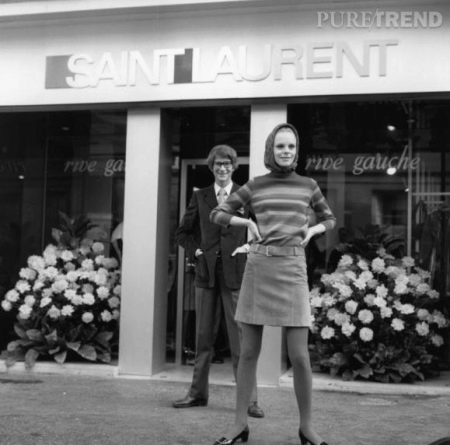
The result of this fashion policy was the triumphant march of unisex style around the world.

The unique ability of the great couturier was the ability to create elegant things, combining high fashion and art with everyday wear. The most famous examples of this combination are the pea coat and tuxedo, which have become the original symbols of the House of YSL, the safari jacket, which delighted with its novelty, transparent blouses that do not hide the beauty of the female body, and delightful wedding dresses.



2002 year
Due to a sharp deterioration in health, Yves Saint Laurent leaves the fashion industry and retires. In the last years of his life, he prefers solitude. Only faithful and loving friends remain with him. In 2008, the fashion king died of brain cancer.

Heritage
Despite the fact that the creator passed away, his ideas, which have become stylish realities, continue to live and improve. In 2017, one of the main fashion trends was elegant unisex: trousers and jeans for a figure, without baggy, original jackets and jackets. The masculine style of clothing, footwear and accessories should emphasize the femininity of their owner.












